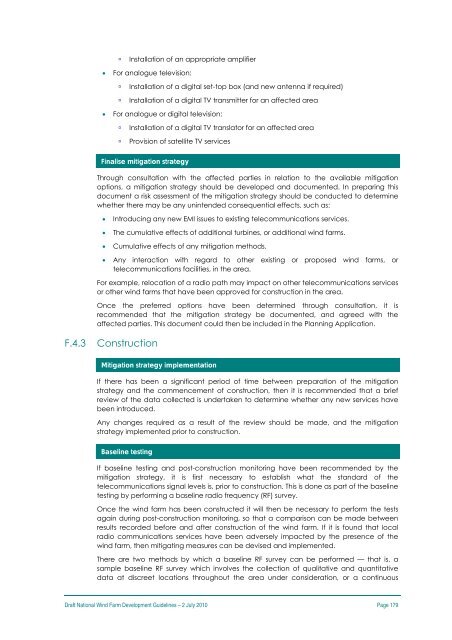Draft National Wind Farm Development Guidelines - July 2010
Draft National Wind Farm Development Guidelines - July 2010
Draft National Wind Farm Development Guidelines - July 2010
You also want an ePaper? Increase the reach of your titles
YUMPU automatically turns print PDFs into web optimized ePapers that Google loves.
Installation of an appropriate amplifier<br />
• For analogue television:<br />
<br />
<br />
Installation of a digital set-top box (and new antenna if required)<br />
Installation of a digital TV transmitter for an affected area<br />
• For analogue or digital television:<br />
<br />
<br />
Installation of a digital TV translator for an affected area<br />
Provision of satellite TV services<br />
Finalise mitigation strategy<br />
Through consultation with the affected parties in relation to the available mitigation<br />
options, a mitigation strategy should be developed and documented. In preparing this<br />
document a risk assessment of the mitigation strategy should be conducted to determine<br />
whether there may be any unintended consequential effects, such as:<br />
• Introducing any new EMI issues to existing telecommunications services.<br />
• The cumulative effects of additional turbines, or additional wind farms.<br />
• Cumulative effects of any mitigation methods.<br />
• Any interaction with regard to other existing or proposed wind farms, or<br />
telecommunications facilities, in the area.<br />
For example, relocation of a radio path may impact on other telecommunications services<br />
or other wind farms that have been approved for construction in the area.<br />
Once the preferred options have been determined through consultation, it is<br />
recommended that the mitigation strategy be documented, and agreed with the<br />
affected parties. This document could then be included in the Planning Application.<br />
F.4.3<br />
Construction<br />
Mitigation strategy implementation<br />
If there has been a significant period of time between preparation of the mitigation<br />
strategy and the commencement of construction, then it is recommended that a brief<br />
review of the data collected is undertaken to determine whether any new services have<br />
been introduced.<br />
Any changes required as a result of the review should be made, and the mitigation<br />
strategy implemented prior to construction.<br />
Baseline testing<br />
If baseline testing and post-construction monitoring have been recommended by the<br />
mitigation strategy, it is first necessary to establish what the standard of the<br />
telecommunications signal levels is, prior to construction. This is done as part of the baseline<br />
testing by performing a baseline radio frequency (RF) survey.<br />
Once the wind farm has been constructed it will then be necessary to perform the tests<br />
again during post-construction monitoring, so that a comparison can be made between<br />
results recorded before and after construction of the wind farm. If it is found that local<br />
radio communications services have been adversely impacted by the presence of the<br />
wind farm, then mitigating measures can be devised and implemented.<br />
There are two methods by which a baseline RF survey can be performed — that is, a<br />
sample baseline RF survey which involves the collection of qualitative and quantitative<br />
data at discreet locations throughout the area under consideration, or a continuous<br />
<strong>Draft</strong> <strong>National</strong> <strong>Wind</strong> <strong>Farm</strong> <strong>Development</strong> <strong>Guidelines</strong> – 2 <strong>July</strong> <strong>2010</strong> Page 179
















